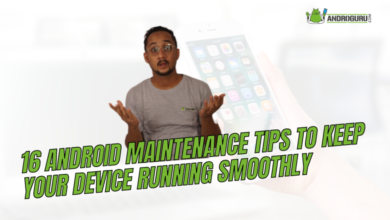How to Choose the Perfect Android Smartphone for You
Discover the essential factors to consider when selecting an Android smartphone that matches your unique needs and preferences.

With the advancement in technology, and Android OS as a specific – I have come across questions from time to time as to “which smartphone is the best to buy” or “the latest Android smartphone worth-buying” that could last 5-6 years.
Joke?
Well, there are so many ways to it while there are so many answers too!
We all know that smartphones have become an indispensable part of our lives. With numerous options available in the market, choosing the right Android smartphone can be a daunting task.
To help you make an informed decision, I have carefully compiled a comprehensive guide with my highly recommended tips and advice. Whether you are a tech enthusiast or a casual user, this article will assist you in selecting the perfect Android smartphone that suits your needs and preferences.
Assess your needs
Before delving into the process of choosing an Android smartphone, it is crucial to assess your needs and requirements. Every individual has unique preferences and priorities when it comes to smartphones, and understanding what you truly need will help guide your decision-making process.
Consider your budget
Determine how much you are willing to spend on a smartphone. This will help narrow down the options and prevent you from overspending. Keep in mind that while flagship devices may offer the latest features, mid-range or budget-friendly options can still provide a satisfactory experience.
Identify your usage patterns
Reflect on how you primarily use your smartphone.
Are you an avid photographer who values a high-quality camera?
Do you engage in heavy gaming or multitasking?
Are you more focused on productivity and require seamless performance?
Understanding your usage patterns will help you prioritize the features that matter most to you.
Prioritize features
Make a list of the features that are essential to you. Consider factors such as display quality, camera capabilities, processor performance, battery life, storage capacity, and connectivity options. This will help you determine which features are non-negotiable and which ones you can compromise on based on your budget.
Evaluate your preferences
Think about the specific aspects that matter to you in a smartphone.
Do you prefer a larger screen size for multimedia consumption or a more compact device for ease of handling?
Are you concerned about the design and aesthetics?
Do you value a stock Android experience or prefer manufacturer customizations?
Understanding your preferences will help narrow down the options and find a smartphone that aligns with your taste.
Consider future needs
While it is essential to focus on your current needs, it is also advisable to consider your future requirements. Think about how long you typically keep a smartphone before upgrading and whether you anticipate any significant changes in your usage patterns over time. Choosing a smartphone that can cater to your evolving needs will ensure that it remains relevant and functional for a longer duration.
By thoroughly assessing your needs, preferences, and budget, you can enter the smartphone market with a clear understanding of what you are looking for. This will enable you to make a more informed decision and select an Android smartphone that suits your lifestyle and enhances your overall user experience. Remember that the perfect smartphone is one that fulfills your specific requirements and brings you joy and convenience in everyday use.
Research and Compare Options
Once you have a clear understanding of your needs, it’s time to dive into research and compare the available options in the Android smartphone market. This step will allow you to make an informed decision by considering various factors and evaluating the features and specifications of different models.
Read expert reviews
Look for reputable technology websites, gadget review platforms, and smartphone-focused publications that provide in-depth reviews and analysis of Android smartphones. These sources often offer valuable insights into the performance, camera quality, battery life, user interface, and other important aspects of each device. Pay attention to both the positives and negatives mentioned in the reviews to get a balanced perspective.
Compare specifications
Visit manufacturer websites or online retailers to gather detailed information about the specifications of various Android smartphones. Compare factors such as processor speed, RAM capacity, storage options, display quality, camera features, and battery capacity. Consider which specifications align with your needs and preferences. Keep in mind that higher specifications often come at a higher price point.
Consider software updates
Check the manufacturer’s track record in terms of providing timely software updates for their devices. Regular updates ensure that your smartphone remains secure and up to date with the latest features and improvements. Manufacturers that have a good reputation for delivering updates promptly are preferable, as they demonstrate a commitment to ongoing support for their products.
Evaluate user reviews
Besides expert reviews, it’s also beneficial to read user reviews and feedback on various Android smartphones. This can provide you with insights into real-world experiences and any potential issues that users may have encountered. Look for common themes or recurring problems mentioned in user reviews to get an idea of the device’s reliability and overall user satisfaction.
Consider brand reputation
Take into account the reputation and track record of the smartphone brand. Established brands often have a solid reputation for quality, reliability, and customer support. They may also offer a wider range of accessories and a strong ecosystem of compatible devices and services. However, don’t overlook newer or lesser-known brands that may offer competitive features and value for money.
Visit retail stores
If possible, visit physical retail stores to get a hands-on experience with different Android smartphones. Explore the user interface, test out the camera capabilities, and get a feel for the device’s build quality and ergonomics. This firsthand experience can help you make a more informed decision and ensure that the device meets your expectations in terms of usability and user experience.
By conducting thorough research and comparing multiple options, you can make a well-informed decision when choosing an Android smartphone. This step allows you to consider various factors such as expert and user reviews, specifications, software updates, brand reputation, and hands-on experience.
Remember that finding the right smartphone is a personalized process, and what works for others may not necessarily be the best fit for you. Take your time, gather information, and make a choice that aligns with your needs, preferences, and budget.
Set a Budget and Consider Value for Money
When choosing an Android smartphone, it’s important to determine your budget and consider the value for money that each device offers. Setting a budget helps you narrow down your options and ensures that you’re not overspending or compromising on essential features.
Establish your budget
Before diving into the smartphone market, determine the maximum amount you’re willing to spend on a new Android device. Consider your financial situation and how much you’re comfortable investing in a smartphone. Smartphones are available in a wide price range, from budget-friendly options to high-end flagship devices. Having a budget in mind helps you focus your search and avoid getting swayed by devices that are beyond your means.
Consider your needs
Assess your specific needs and priorities in terms of smartphone features and capabilities. Make a list of the features that are essential to you, such as camera quality, processing power, display resolution, battery life, and storage capacity. Determine which features are non-negotiable and where you may be willing to compromise to stay within your budget.
Evaluate value for money
Once you have a budget and a list of desired features, start evaluating the value for money offered by different Android smartphones. Consider the price-to-performance ratio and assess whether a particular device offers a good balance between price and features. Look for devices that provide the features you need at a reasonable price, even if they may not have all the bells and whistles of higher-priced options.
Compare prices
Research online retailers, physical stores, and e-commerce platforms to compare prices of Android smartphones that meet your criteria. Look for ongoing deals, discounts, or special offers that may make a particular device more affordable. Keep an eye on the prices of previous-generation models, as they may offer similar features at a lower cost compared to the latest releases.
Consider long-term costs
While the upfront cost of a smartphone is important, it’s also crucial to consider the long-term costs associated with owning the device. Take into account factors such as potential repair costs, warranty coverage, and availability of affordable accessories. Additionally, consider the software and app ecosystem associated with the device, as certain platforms may offer more free or affordable applications and services.
Read customer reviews
Customer reviews and feedback can provide valuable insights into the value for money offered by different Android smartphones. Look for reviews from users who have had the device for an extended period, as they can share their experiences regarding durability, performance, and overall satisfaction. Reading reviews can help you gauge whether a particular smartphone provides good value for its price.
By setting a budget and considering the value for money, you can ensure that you make a wise investment when choosing an Android smartphone.
Establishing your budget helps narrow down your options, while evaluating the value for money ensures that you get the features you need without overspending. Remember, it’s important to strike a balance between price and features to find a device that meets your requirements and provides a satisfactory user experience.
Research and Compare Specifications
Researching and comparing specifications is a crucial step in choosing the right Android smartphone for yourself. It allows you to assess the hardware and software features of different devices and determine which ones align with your needs and preferences. Here are some key factors to consider when evaluating specifications:
Processor and RAM
The processor (CPU) and RAM (random access memory) are essential for the device’s performance and multitasking capabilities. Look for smartphones with powerful processors that can handle your desired tasks efficiently, whether it’s gaming, multimedia, or productivity. Consider the amount of RAM as well, as higher RAM ensures smoother multitasking and better overall performance.
Storage Capacity
Evaluate the storage capacity offered by different Android smartphones. Determine how much internal storage you require to accommodate your apps, media files, and documents. Some devices allow expandable storage through a microSD card, which can be beneficial if you need additional space in the future.
Display Quality
The display is a significant aspect of any smartphone. Consider factors such as screen size, resolution, and display technology. A larger screen may enhance your multimedia experience, while a higher resolution provides sharper visuals. Additionally, various display technologies, such as LCD, OLED, or AMOLED, offer different levels of color accuracy and contrast. Choose a display that suits your preferences and usage patterns.
Camera Capabilities
If photography is important to you, pay attention to the camera specifications. Look for devices with higher megapixel counts for better image quality. Consider additional features such as optical image stabilization, low-light performance, and the availability of manual controls or AI-assisted photography. Check sample photos taken with the device or read camera reviews to get an idea of the image quality.
Battery Life
Evaluate the battery capacity and efficiency of different smartphones. Consider your typical usage patterns and how long you need the device to last on a single charge. Look for devices with larger battery capacities and efficient power management features that can provide extended usage time. Also, check if the device supports fast charging or wireless charging, which can be convenient for quick top-ups.
Connectivity Options
Assess the connectivity options provided by the smartphone. Ensure that it supports the necessary network bands for your region and offers fast data connectivity such as 4G or 5G. Consider other connectivity features like Bluetooth, Wi-Fi, NFC, and USB-C for seamless connectivity with other devices and peripherals.
Operating System and Updates
Android smartphones come with different versions of the operating system. Research the version pre-installed on the device and check for the manufacturer’s track record in providing software updates. Opting for a device with the latest OS version and a good history of timely updates ensures access to new features, improved security, and compatibility with future applications.
Additional Features
Take note of any additional features that may be important to you. This could include fingerprint sensors, facial recognition, water resistance, dual SIM support, stereo speakers, or headphone jacks. Consider these features based on your personal preferences and requirements.
By researching and comparing specifications, you can find an Android smartphone that meets your performance, storage, display, camera, battery, and connectivity needs.
Understanding the significance of each specification allows you to make an informed decision and choose a device that aligns with your preferences and intended usage. Remember to prioritize the specifications that matter most to you and strike a balance between them to find the perfect Android smartphone for yourself.
Consider the Price and Value for Money
When choosing an Android smartphone, it’s essential to consider the price and value for money that a device offers. Here are some factors to consider regarding pricing:
Budget
Determine your budget range before starting your search. This will help narrow down your options and prevent you from overspending. Android smartphones come in a wide price range, from budget-friendly options to high-end flagship devices. Assess your financial capabilities and set a realistic budget that suits your needs.
Value for Money
While it’s tempting to go for the latest and most expensive smartphone, it’s important to assess whether the device offers good value for money. Consider the overall package and what you’re getting for the price. Look at the specifications, features, and user reviews to gauge if the device justifies its cost.
Longevity
Think about the longevity of the device. A higher-priced smartphone might offer better build quality, durability, and longer software support. It can be more cost-effective in the long run, as it will likely last longer before becoming outdated or requiring replacement.
Compare Prices
Research and compare prices from different retailers and online platforms. Prices may vary, and you may find deals or discounts that can save you money. Consider buying from authorized sellers or reputable retailers to ensure genuine products and reliable after-sales support.
Consider Refurbished or Pre-owned Options
If you’re on a tight budget, consider refurbished or pre-owned Android smartphones. These devices have been professionally restored or lightly used, offering a more affordable alternative. However, be cautious when purchasing refurbished devices and ensure they come with a warranty or guarantee.
Balance Features and Price
Strike a balance between the features you need and the price you’re willing to pay. Avoid overspending on features you won’t use or sacrificing essential features to save money. Assess your priorities and find a device that offers a good balance of features within your budget.
Consider the Total Cost of Ownership
Apart from the upfront price, consider the total cost of ownership, including any additional accessories or peripherals you may need to purchase. Some smartphones may require specific chargers, cases, or other accessories that can add to the overall cost.
By considering the price and value for money, you can make a more informed decision about which Android smartphone is the best fit for your budget and needs. Remember that price is not the sole determinant of quality or user satisfaction. Assess the overall package, compare options, and prioritize the features that matter most to you while staying within your budgetary constraints.
Assess the Camera Quality and Features
The camera has become one of the most important features for smartphone users, and if photography is a priority for you, it’s crucial to assess the camera quality and features of an Android smartphone before making a purchase. Here are some factors to consider:
Megapixels
While megapixels alone don’t determine the overall camera quality, they do play a role in capturing more detail and producing sharper images. Look for a higher megapixel count, such as 12MP or more, for better image resolution.
Sensor Size
The sensor size is another critical factor affecting image quality. A larger sensor can capture more light, resulting in better low-light performance and improved dynamic range. Look for smartphones with larger sensor sizes, typically mentioned in inches, for enhanced image quality.
Aperture Size
The aperture size refers to the lens opening that controls the amount of light entering the camera. A wider aperture (represented by a smaller f-number) allows more light, leading to better low-light photography and background blur effects. Look for smartphones with wider apertures like f/1.8 or f/1.4 for improved versatility.
Image Stabilization
Optical image stabilization (OIS) or electronic image stabilization (EIS) can significantly enhance image and video stability, reducing blur caused by shaky hands or movement. This feature is particularly useful for capturing action shots or recording videos. Look for smartphones with some form of image stabilization for smoother and sharper results.
Camera Modes and Features
Assess the available camera modes and features offered by the smartphone. Popular features include portrait mode, night mode, panorama, HDR (high dynamic range), and various filters. Consider your photography preferences and look for a device that offers the modes and features that align with your interests.
Video Recording
If you frequently record videos, pay attention to the smartphone’s video recording capabilities. Look for features like 4K video recording, slow-motion, and the availability of video stabilization for smoother footage. Additionally, consider the maximum frame rate and resolution options supported by the camera.
Front-facing Camera
Don’t overlook the front-facing camera, especially if you enjoy taking selfies or engaging in video calls. Assess the resolution, aperture, and any additional features offered by the front-facing camera.
Reviews and Sample Images
To get a better understanding of the camera performance, search for reviews and sample images captured with the smartphone you’re considering. This will give you real-world insights into the image quality, color accuracy, dynamic range, and overall camera performance.
It’s worth noting that while higher-end smartphones often offer superior camera capabilities, some mid-range or budget-friendly options can also deliver impressive results. Consider your photography needs, compare camera specifications, and make an informed decision based on your preferences and budget.
Remember, camera performance is subjective, and what works for one person may not necessarily work for another. Take into account your specific requirements and prioritize the camera features that matter most to you, whether it’s image quality, low-light performance, or creative shooting options.
Consider Battery Life and Charging Options
Battery life is a critical aspect to consider when choosing an Android smartphone, as it directly affects the device’s usability and convenience. Here are some factors to keep in mind regarding battery life and charging options:
Battery Capacity
The battery capacity, usually measured in milliampere-hours (mAh), indicates how much power the battery can hold. Generally, a higher mAh rating translates to longer battery life. Look for smartphones with larger battery capacities to ensure sufficient power throughout the day, especially if you are a heavy user or frequently use power-intensive applications.
Screen-on Time
The screen-on time refers to the duration the display remains active while using the smartphone. It is a crucial factor in determining how long the battery will last. OLED or AMOLED displays tend to be more power-efficient than LCD screens, as they only illuminate individual pixels when necessary. Consider smartphones with efficient display technologies to maximize battery life.
Power Efficiency
Beyond battery capacity, the power efficiency of the smartphone’s components and software optimization also plays a significant role in determining battery life. Some manufacturers employ power-saving features and intelligent software algorithms to optimize power consumption and prolong battery performance. Look for smartphones with good power efficiency ratings or those that offer power-saving modes to extend battery life when needed.
Charging Options
Evaluate the charging options available with the smartphone. Most modern Android smartphones support fast charging technologies, which enable quicker charging times. Check if the device supports any specific fast charging standards, such as Qualcomm Quick Charge or USB Power Delivery, as they can significantly reduce the charging time. Additionally, some smartphones may offer wireless charging capabilities, providing a convenient way to charge the device without the need for cables.
Battery Longevity
Consider the long-term durability and performance of the smartphone’s battery. Lithium-ion batteries, commonly used in smartphones, gradually lose their capacity over time. However, some manufacturers may incorporate battery health optimization features or replaceable batteries to prolong the device’s overall battery life. Research the reputation of the smartphone brand and any additional measures they take to ensure long-lasting battery performance.
User Reviews and Tests
To gain insights into the real-world battery performance, read user reviews and look for independent battery tests conducted by reputable sources. These reviews often provide valuable information about how long the battery lasts under different usage scenarios, such as web browsing, video playback, or gaming.
It’s important to note that battery life can vary based on individual usage patterns, settings, and applications running in the background. Your smartphone usage habits will influence the actual battery performance you experience. Consider your typical daily usage, the availability of charging options throughout the day, and choose a device that aligns with your needs.
In conclusion, when selecting an Android smartphone, carefully assess the battery capacity, power efficiency, charging options, and long-term battery performance to ensure that the device meets your usage requirements and offers a satisfactory battery life.
Connectivity Options
When choosing an Android smartphone, it is essential to consider the connectivity options available to ensure that the device can seamlessly connect to various networks and devices. Here are some key aspects to consider regarding connectivity options:
Cellular Connectivity
Check if the smartphone supports the necessary cellular network bands for your region. Different smartphone models are designed to work with specific bands, so ensure compatibility with your preferred carrier’s network. Look for smartphones that support 4G LTE or 5G connectivity for faster data speeds and better network coverage.
Wi-Fi
Wi-Fi connectivity allows you to connect to wireless networks, such as home or public Wi-Fi hotspots, for faster internet access. Ensure that the smartphone supports the latest Wi-Fi standards, such as 802.11ac or 802.11ax (Wi-Fi 6), to take advantage of faster connection speeds and improved network stability.
Bluetooth
Bluetooth enables wireless communication between your smartphone and other compatible devices, such as headphones, speakers, or smartwatches. Check if the device supports the latest Bluetooth version to ensure compatibility with a wide range of accessories and enjoy enhanced data transfer speeds and improved energy efficiency.
NFC
Near Field Communication (NFC) allows your smartphone to interact with other NFC-enabled devices or tags by simply bringing them close together. NFC facilitates various tasks like contactless payments, file sharing, or pairing with compatible devices. If you plan to use these features, ensure that the smartphone has NFC functionality.
GPS
Global Positioning System (GPS) is crucial for accurate location tracking and navigation. Most smartphones today come with built-in GPS capabilities, but some may also support additional navigation systems like GLONASS or Galileo. If you rely on GPS for navigation or location-based services, ensure that the device offers reliable and accurate GPS functionality.
USB Connectivity
USB connectivity allows you to connect your smartphone to other devices like computers, laptops, or external storage devices. Check the type of USB port available on the smartphone, such as USB Type-C, which offers faster data transfer speeds and improved convenience due to its reversible design. USB OTG (On-The-Go) support is also desirable if you want to connect USB peripherals directly to your smartphone.
Other Connectivity Features
Consider any other connectivity features that may be important to you. For example, some smartphones offer infrared (IR) blasters that enable you to use your phone as a remote control for various appliances. Additionally, features like Dual SIM support or a dedicated microSD card slot for expandable storage can provide added flexibility based on your needs.
Choosing the right Android smartphone requires careful consideration of your needs, budget, and preferences. By following the tips and advice outlined in this comprehensive guide, you can make an informed decision and select a device that perfectly aligns with your requirements.
Remember to research, compare, and prioritize the features that matter most to you. With the vast range of Android smartphones available, finding the perfect one that meets your expectations is an exciting journey.











